This is the adapted text of the presentation given by Katharine Coles, poet in residence at the Poetry on the Move festival 2015, demonstrating Poemage, a computational tool developed by a team of poets and computer scientists.
Keywords: poetry — computer — poemage
Among things I call myself is an ‘accidental digital humanist’. When I was asked by Oxford University computer scientist Min Chen to join him and his team on a poetry project, one goal of which would ultimately be to create a visualization tool to aid poets and poetry scholars in the close reading of poetry, I told him to find someone else, because ‘I don’t count nouns’.[1]
The perception persists among many of us engaged in research and practices at the heart of the Humanities—close reading, textual theory, the writing of poems—that Digital Humanities research concerns itself primarily with what the technically-oriented are most interested in, the quantification of texts or their features, rather than what we may most care about: a qualitative, aesthetic experience that my colleague Scott Black describes in conversation as the ‘slower, less narcissistically-networked, and less productive practices of attention.’ Black values ‘literature as reading, reading as attention: and the humanities as a space for those less instrumental, even useless, experiences of wonder and enchantment’.
As a seeker of ‘useless experiences’ myself, I have thought of the computer as relentlessly utilitarian, driven to help me perform as much work as possible as quickly as possible and at the same time to distract me from my work, insistently—keeping me from becoming absorbed and therefore ‘productive’ in the fullest and the happiest sense. In most activities, whatever time the computer saves me it simultaneously usurps for itself, so the browsing I might be doing in the fields of enchantment is given over to another kind of browsing, in which my purpose, or purposefulness, is given, or taken, over.
Of course, the quantifying machine has brought visible and valuable gains to Humanities research, including, for example, work on archives, on authorship, or on tracking trends. As important and as laborious to achieve as gains in these fields have been, they represent for Digital Humanities low-hanging fruit: both the potential value of computers to the work and myriad potential paths to extracting that value have been, though not always easily or immediately fulfilled, at least apparent. These activities can be largely addressed with minimal adaptation by existing digital tools, so don’t require the development of new computational strategies, much less new frameworks or paradigms. Users don’t have to push the tool to get it to perform its tasks—and neither, in performing them, will the tool push us, theoretically or otherwise.
Because the computer hadn’t seemed to be obviously adaptable to our research goals, which are centered around composition and close reading of poetry by actual humans, at the beginning of this work my postdoctoral fellow Julie Lein and I were skeptical about giving the computer more space in our lives. We feared we might be tempted to let the computer shape both how we work and also the work we do, in a way that might be detrimental. We feared that we would be tempted to limit our work to what available tools could already do, rather than creating new tools that address our existing needs or that enrich or extend the values and practices that we believe should remain at the heart of Humanities research.
Indeed, our thinking about our work, and even our processes, did change as we adapted ourselves to the needs of our colleagues and their hypnotically humming boxes. However, we found that these adaptations, directed toward helping our colleagues create tools that would in fact address our existing practices, had the potential to enhance rather than detract from those practices. Since my initial, somewhat skeptical response to Min’s generous invitation and the beginning of a subsequent project with computer scientists Miriah Meyer and Nina McCurdy at the University of Utah, it has become clear that simply describing to computer scientists how poems operate and what I care about in them, and looking at and responding to their digital interpretations of what I say, is in itself interesting and useful.
It has also changed how I think and therefore talk about poems, specifically asking me to shift my initial attention away from the meanings of poems and onto their operations, toward observing how elements and features are built to operate together as a complex in the poem. But this wasn’t a huge shift for me. I have always been interested in looking at a poem’s moving parts and their relationships to each other not only as ‘evidence’ that might point me to some larger conclusion but also as interesting and productive in their own terms. It may be that an interest in this kind of reading is a natural outgrowth of reading alongside computers—perhaps describing poems to computers (or their handlers) leads us to focus on those features that are amenable to such description. But I connect my own interest in poetic operations, which precedes the computer work by decades, to the fact that as a poet, like any magician who wants to learn all the tricks of the trade, I am riveted by technique, by mirrors and false-bottomed boxes and trap doors.
Since a poem’s meaning and its operations can’t actually be separated, this focus on operation is a matter of emphasis only. After all, the paradox at the heart of poetic language, a paradox engaging both operation and meaning, is that it deploys maximum precision in the service of maximum complexity, and therefore of sometimes wild indeterminancy, on the levels of word and syntax. The work of poetic language, as Gillian Beer suggests in her wonderful essay, ‘Problems of Description in the Language of Discovery’, is to deploy all possible productive meanings across the space-time of the poem. This is a matter not of magic but of technique.
Tools that existed when we began our project didn’t address how a poem works out its complexities in the time and space it creates. Even the best (in our view) tool then available for visualizing individual poems, Myopia, relies not on enhancing the reader’s real-time, qualitative experience of a poem of her choosing, but rather on providing, through meticulous hand coding, the existing knowledge of one scholar, Laura Mandell, about a pre-selected (by Mandell, not the reader) poem—specifically on naming the figures and devices in use. Because Mandell’s knowledge is thorough, Myopia is extremely useful as a pedagogical tool; however, it leaves little or no room for the kinds of exploratory experiences Julie and I, along with many other readers of poetry, most value.
To teach us about poetry in a meaningful way, a computational tool must engage the richness and ambiguity of a poem in order to enable and enhance the reader’s interaction with it. But before a computer can teach us about a poem, we must learn to teach computers about poetry. Thus, we need not only to understand what about poetry can actually be quantified, but more importantly to understand what the reading experience entails: not only what a poem does, but how.
Of course, the computer scientist, not the poet, teaches the machine. What, then, do we need to tell computer scientists about poems to help them do this? And if we can even figure out what computer scientists need to know about poems to help us, can we be precise enough about poems to tell them? Our collaborators needed to know not only, yes, what poems are ‘like’, but also what exactly we wanted the computer to capture.
The work began at the e-Research Centre at Oxford University in a three-day meeting with Min and his team, my post-doc Julie Gonnering Lein at the University of Utah, and myself. The issue of specificity became foregrounded for me when, early on the first day, Min asked me what—and he meant what exactly—I meant when I talked about ‘poetic time’, a term I have long enjoyed tossing around but had never actually tried to define with any kind of precision. This question was one of many the answers to which I ‘knew’ not consciously but intuitively and practically, in ways I hadn’t articulated. When, in response, I first wrote out Louise Bogan’s ‘Night’ (choosing it because it seemed appropriate and I had it by heart) on the whiteboard, I thought I was going to say something about the temporal development of the poem’s imagery (which I have since written about in relation to this project):
NIGHT
The cold remote islands
And the blue estuaries
Where what breathes, breathes
The restless wind of the inlets,
And what drinks, drinks
The incoming tide;
Where shell and weed
Wait upon the salt wash of the sea,
And the clear nights of stars
Swing their lights westward
To set behind the land;
Where the pulse clinging to the rocks
Renews itself forever;
Where, again on cloudless nights,
The water reflects
The firmament’s partial setting;
—O remember
In your narrowing dark hours
That more things move
Than blood in the heart.
But from my planned discussion of imagery I quickly detoured into sound, because it lends itself to precision: together, we could follow the long ‘o’s through the first line and watch them change into other sounds in a movement that operates both forward and backward and so enacts the surges and recursions of poetic time. Later, we were led to focus on the shifting, clustered repetitions of sound beginning in ‘estuaries’ and ‘breathes’ and moving through ‘restless’ and ‘inlets.’ Here sounds don’t so much repeat as overlap; as they enact change and delay across syntax and so keep the time of the poem, showing us how, as Julie observes, ‘time emerges through movement and rest.’
This discussion led to our initial focus on visualizing sound, and also eventually to the overarching metaphor for our work thus far: ‘flow,’ which we define as ‘a fluid (or fluids) moving via its linguistic devices and figures through a defined space’. This metaphor allows us to remember that, though its movement is highly structured, poetry offers the reader immense freedom to create the conditions of its structuring through reading, which brings the poem into time by releasing the turbulences captured within it. The metaphor of ‘flow’ illuminates our need to identify not a given poetic element in a static way, but rather how the element becomes part of a complex of relationships that enables a given poem to move in time. This is a profound question, one most computer tools, like most poetry textbooks, have not addressed.
Further, once we identify those interactions that enable a poem to move—or, as I have meant to suggest, that enable a reader to move a poem and move within it—we need to be able to describe them, to people and machines, both in isolation and as they work together. As this interaction is, in its essence, qualitative and experiential, at once mental and physical, it also may be irreducibly complex. Certainly, it seems so when one is actually trying to reduce it. If sound emerged as being a poetic feature that, while finally not separable from other components within the poem, could at least be pulled out and looked at in its own terms, it also had elements that seemed potentially subject to computer analysis through quantification. It is possible to isolate sonic features from other features (acknowledging of course that the sonic features of a poem are constantly at play with every other feature) and also to isolate specific sounds.
The tool we developed out of our discussions with the Oxford team is called Poem Viewer, which does some interesting things but essentially treats the poem as linear:
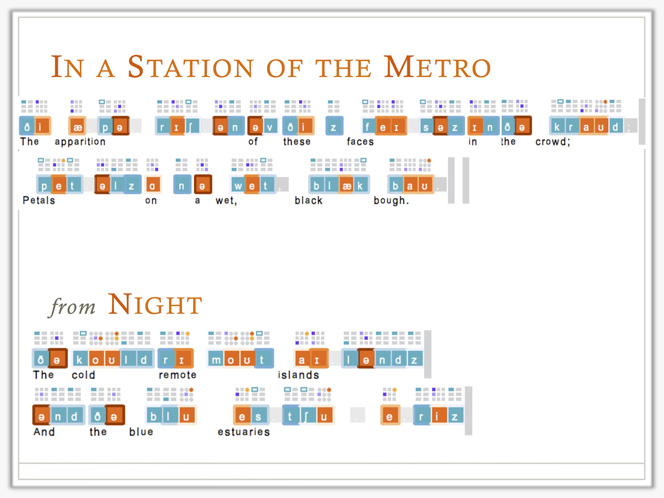
The partnership around the Poemage tool [2], which Julie and I are working on with computer scientists Miriah Myer and Nina McCurdy at the University of Utah’s Scientific Computing and Imaging Institute (SCI Institute), evolved from a commitment to honor not only a poem’s linear temporality but also what we call the poem space, the shape of the poem on the page that allows its temporality to operate multi-directionally and multi-dimensionally. As Julie and I encountered a series of prototype visualisations and representations, always accompanied by the question of whether they showed us anything we really wanted to know, we became increasingly focused not on what features of a poem we might be able to identify in isolation, but rather whether we can identify how and where these features become, through lively interaction across the space and syntax of the poem, interesting.
‘Interesting’ is, we recognise, a problematic word. We use it here to refer to something that has the capacity to arrest and absorb, to cause the reader to enter a state of ‘flow’ by entering the flow of the poem. While any tool dealing with sound must, for example, be able to show us where exact end rhyme is occurring in a poem, end rhyme is, first, a feature an experienced reader can identify almost as quickly as a machine, and, second, rarely in itself as interesting as subtler variations like slant rhyme and pararhyme.
Still, Poem Viewer and early versions of Poemage showed us that none of these kinds of rhyme alone can capture how a poem arrests us with sound—for example, our favorite sonic movement in Bogan’s ‘Night,’ from ‘estuaries’ to ‘breathes’ to ‘restless’ to ‘inlets.’ Most interesting, we then realised, are places where sonic and other poetic devices rub against each other or overlap rather than reproducing themselves—and, not surprisingly, these are precisely the places where we find turbulence, the overlapping sonic moments that create a poem’s evolving sonic identity.
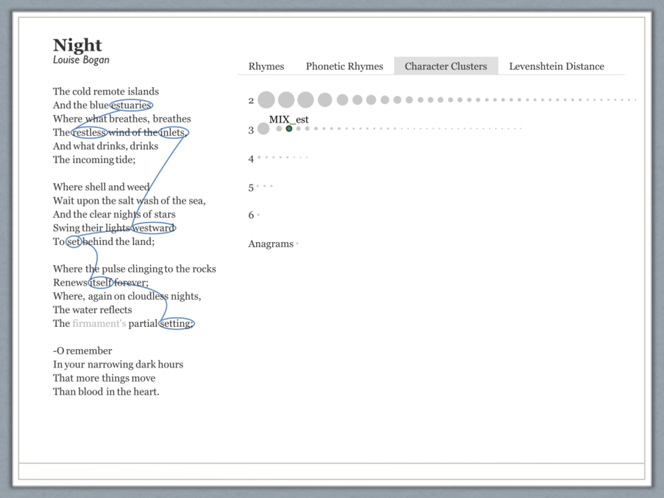
This screenshot of a sketch version of Poemage shows a variety of rhyme types in ‘Night’ and also allows the reader to perceive at a glance which types are dominant.
I have already mentioned the progression in ‘Night’ from ‘estuaries’ to ‘breathes’ to ‘restless’ to ‘inlets’. Our analysis of this progression first arose before the tool existed, out of Julie’s and my imagining and describing what our dream tool might pick up. To capture the progression of sonic clusters as they repeat in different combinations, often across syllables, presented a computational problem that required our second set of sonic collaborators to solve an open problem in computer science, and led to the development of a new algorithm, RhymeDesign, which allows users to query a broad range of sonic patterns[3]. Built on top of RhymeDesign, Poemage, still in early prototype stage, allows users to explore the interactions of sonic patterns within the poem space.

The process I have described suggests that the benefits of working on the tool don’t inhere only in what the tool itself can tell me—far from it—or even only in what a tool sends me back to the poem to experience more fully for myself. The very need to think about poems precisely enough to teach a machine to read even one poetic operation has led us to new insights about poems, both theoretical and specific. While our first set of discussions led to our focus on sound, for example, I have not let go of the desire to think as precisely as possible about other poetic features, like image and metaphor, and how they operate—features that at the moment are not yet tractable (because they are, computationally speaking, ‘open problems’), but that we hope to begin to approach through our work. Perhaps even more important is the question of syntax, which creates the linguistic field from which everything else in the poem arises and across which all its devices, including sonic devices, play.
In my considerations of how sound operates across this field, I kept inevitably returning to what Poemage, in dealing with the poem space, already so beautifully captures: how, in a poem, sound becomes inherently recursive, suspending the reader in place even as she moves forward via her reading. Barthes coined the term ‘dilatory space’ [page] to describe narrative actions that inhibit forward motion and thus are closely related to the more inherently recursive movements of lyric. Peter Brooks describes it as ‘the space of retard, postponement, error, and partial revelation,’ which is also ‘the space of transformation’ [page]. Though the prose poem delightfully complicates the distinction, one difference between most prose and most poetry is precisely in the way poetry defines its own space formally in relation to time. Thus, when I consider the term ‘dilatory space,’ I imagine not only willful postponement but also a movement that is temporal and at once bounded and dramatic: the pupil of an eye opening into vision that can be dizzying in its velocity.
I shall return to the idea of ways the very idea of the tool pushes my thinking. But first, let me see if I can tell you—and show you—how, now that I (often restlessly) have been using the tool, the tool itself can help me read, without, thank goodness, coming between me and the poem. Last year, pursuing some thinking about Dickinson, I encountered a little-known poem, usually numbered 315.
He fumbles at your Soul
As Players at the Keys
Before they drop full Music on —
He stuns you by degrees —
Prepares your brittle Nature
For the Etherial Blow
By fainter Hammers — further heard —
Then nearer — Then so slow
Your Breath has time to straighten —
Your Brain — to bubble Cool —
Deals — One — imperial — Thunderbolt —
That scalps your naked Soul —
When Winds take Forests in their Paws —
The Universe — is still — (496)
We tend to stereotype Dickinson as being sonically predictable—the joke in the United States is that you can sing any of her poems to ‘The Yellow Rose of Texas,’ or to any Anglican hymn—but as far as rhyme goes she is actually anything but. She might maintain a rhyme scheme throughout—or start with a regular rhyme scheme, then completely abandon it, then return to it. Sometimes she rhymes all the lines, sometimes only the second and fourth. Always, she varies. As I read this poem, I can’t escape the way she manages to create a kind of sonic that gives the impression, the illusion, that she is rhyming, even when she is not. I had a hypothesis about how she does this, but I wanted to see if the tool could show me the sonic richness and hyper-connectedness I expected to see in the poem. In other words, I was beginning with a specific hypothesis. As our computer science grad student Nina said to me the other day, ‘Oh my God, you’re working like a scientist’.
I don’t know about that. But in the Dickinson, you’ll notice without any recourse to the computer that aside from the exact rhyme of ‘soul’ with ‘soul,’ which occurs across almost the entire poem space, the only indisputable full end rhyme is ‘blow’ with ‘slow,’ which I note has all the same sounds as ‘soul,’ no more and no fewer, in different order. I also want to count "degrees" as rhyming not just with ‘keys’ but with ‘the keys’. But once we start down this road, where do we end? We don’t want to miss how she gets ‘He fumbles’ at the beginning of line one to sound as if it rhymes with ‘he stuns you’ at the beginning of line three. I am tempted to call this the Dickinson ‘what the hell’ rhyme.
It’s hard for me to say exactly when I took this poem to the machine. Was it before or after I noticed the peculiar assonance/consonance combo that makes ‘fumble’ rhyme with ‘soul’, or how it rhymes with ‘brittle’ in two ways, through ‘character rhyme’, which is visual, and in ‘ul’. But at some point, I began to focus on ‘soul’ as the rhyming heart of the poem, and to speculate that Dickinson seems to have connected it sonically to nearly every other important word.
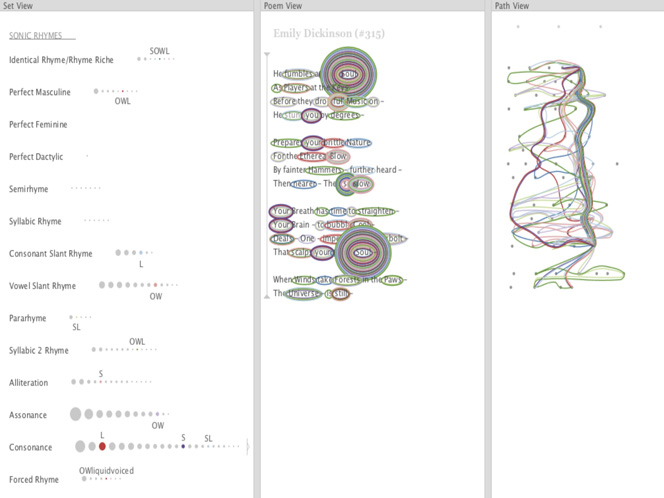
The tool shows that this is true, and also, if we wish, will direct our attention to certain kinds of relationships. This screenshot includes, on the left, a menu of sonic relationships I can select from to visualise when I hover over ‘soul’. In the middle, you see how heavily specific words are implicated in the multiple relationships being mapped. And on the right, you see how the relationships exist within the poem space. In this closer view of the screen, I’ve chosen to make the implicated words visible in the right-hand screen, beneath the abstraction.
What we are seeing, I believe, is a web of sonic relationship so dense that nearly every word is sonically connected to nearly every other. Under the force of meter, this creates a sense of rhyme where conventional rhyme doesn’t exist in the poem. For me, the ultimate result is that in its final couplet (we are working with a sonnet here) the poem insists that ‘paws’ and ‘still’ rhyme. This sense is heightened by the homonym in ‘pause’, of course; it speaks to ‘still’ thematically and also sonically through words that reach all the way up through the poem to ‘players’ and back. By now, of course, ‘still’ must rhyme with ‘soul,’ so dense is the patterning that joins them. Notice that by this time I am neither working only with the text on the page or only with the visualisations. I am moving back and forth between them, letting the machine constantly send me back to the poem, rather than replacing it.
Looking forward, we are hoping to address image and metaphor, though these are such huge open problems we will have to figure out how to bootstrap our way into them. As I mentioned, thinking ahead with the recursiveness of sonic action as my context, I have begun to apply my thinking to the image, and in particular how our conventional idea of the image as static or at least as enacting a kind of stillness in the poem is not only imprecise and inaccurate but also again less interesting than what is really happening between poem and reader as an image takes its shape or its place through linguistic and formal operations. Our working hypothesis, which seems to hold, is that sonic activity can help us think about turbulence in the image as well. The short version of that talk would be to put up a slide of William Carlos Williams’ ‘Red Wheelbarrow’ with Magritte’s disclaimer: ‘This is not a red wheelbarrow.’
Poets working with us now have been using Poemage not only for close reading but also in their own creative projects. Amanda Hurtado has been using it to create erasure poems. As we know, erasure is an exercise in sensibility, in removing words from another person’s text to create a new text that both converses with the original and reflects the voice and view of the poet doing the erasure. The intervention of the machine doesn’t change this imperative, for me—and of course what the machine provides is only a suggestion. The sensibility of the poet using the machine will determine whether, for example, she limits herself to selecting only words the machine presents or allows herself more leeway.
As some of you know, I particularly love the opportunities for theft provided by the cento. ‘Cento on Pi Day,’ written on March 14, 2015, takes its lines from mathematician Manil Suri’s op-ed, ‘Don’t Expect Math to Make Sense’, from the New York Times of that day. As I drafted, I was unhappy—I was fully engaged by the essay’s ideas, but the language wasn’t achieving a texture that felt like my own, which is of course the point of such theft. On a whim—what did I have to lose?—I dumped it into the machine, and noticed that its most common word, and so its most common point of sonic relationship, was ‘is’:

That sounds like a mathematician writing for the newspaper, even a mathematician writing well, but it’s unlike me—except, insofar as I too can be overly tempted by idea, by stasis. I ran the poem through a few more noodlings, hoping to approach it again through sound rather than idea, and I noticed that two of the most strikingly related words were ‘circle’ and ‘asphyxiated’, both of which connect with ‘Pythagoras’. This observation led me not to rewrite (this is a cento after all) but to rearrange the poem with ‘Pythagoras’ and ‘asphyxiated’ coupled nearly dead center.
It also pairs ‘this’ and ‘exist’, ‘never’ and ‘meandering’, very explicitly, and puts into proximity ‘circle’ and ‘material’, ‘where’ and ‘or’. I am not sure the poem is done, or even that it will be, but it is closer to where I would like it to be in its chimings.
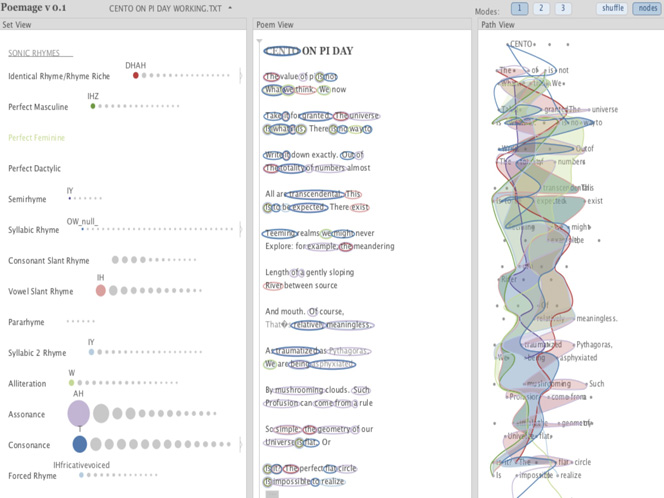
Our younger poet-scholars are pushing the tool’s potential for making new poems and for making them in ways that extend disciplinary boundaries much farther than I do. A research paper on Poemage was recently accepted by IEEE InfoVIS, the big international scientific visualisation conference for computer scientists. Alongside the paper, a smaller project was accepted for VisApp as a part of their ‘data improvisations’ section, a kind of conference art gallery. For this project, Nina McCurdy, Julie Lein, and Amanda Hurtado created 3D visualisations of various poems, again working toward giving viewers an apprehension of the poems’ space-time. The installation included both still images and a video loop of the visualisations in motion. I emphasise that these still images are meant to be both interpretive and aesthetic—they are based in the science, but they stretch it.
Here is Julie’s ‘spun’ version of Dickinson’s ‘As if some little Arctic flower’:
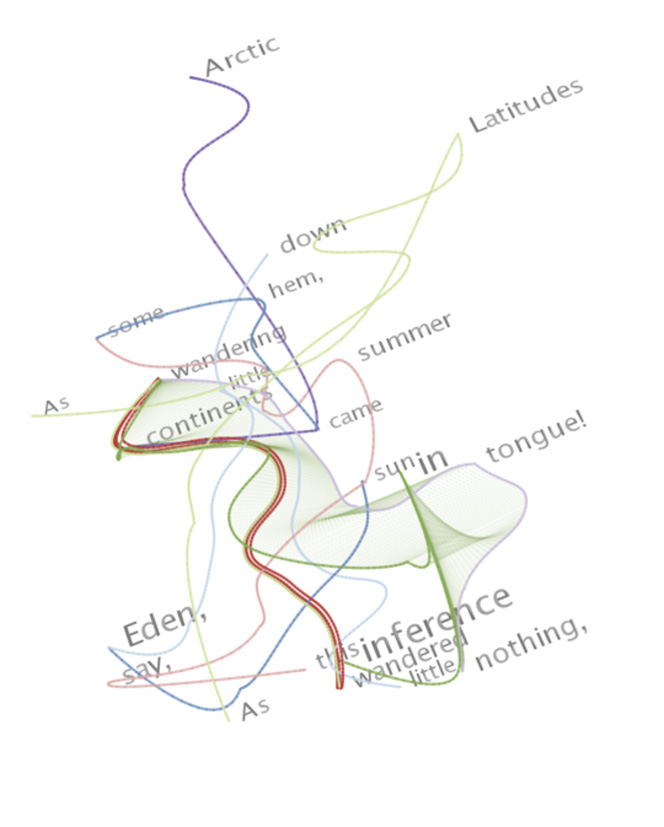
About it, she says:
This visualization preserves the structure and order of Dickinson’s original poem; the words and arrangement of that text supply the data required by this encoding strategy to calculate poetic ‘depth’ as degree of sonic change, word by word, through her poem. At the same time, the visualization also captures a particular reader-user’s perspective—a perspective which, by virtue of the malleable 3D white space between visualized words, rearranges those words into a new reading order and changes textual emphasis by bringing some words into prominence, obscuring others, and even creating new ones not present as such in the original (e.g. ‘aft’).
By exploring an original poem in this way, poet-readers can discover and select (re)arrangements whose meanings relate to, but also move beyond, meanings supported by the source poem. Having selected such an angle based on its perceived poetic interest, a poet-reader may make further artistic choices—e.g. how to render ambiguous lineation, whether/how to retain partially obscured words. The resulting ‘spun poem’ bears similarities to erasures, centos, found poetry, and other formal styles that make explicit use of source texts while also expressing a new poet’s work and new textual meanings. Unlike those forms, however, it also relies on 3D visualization technology.
For the computer scientist’s take, we have Nina McCurdy’s visualisation of Shakespeare’s Sonnet #18:
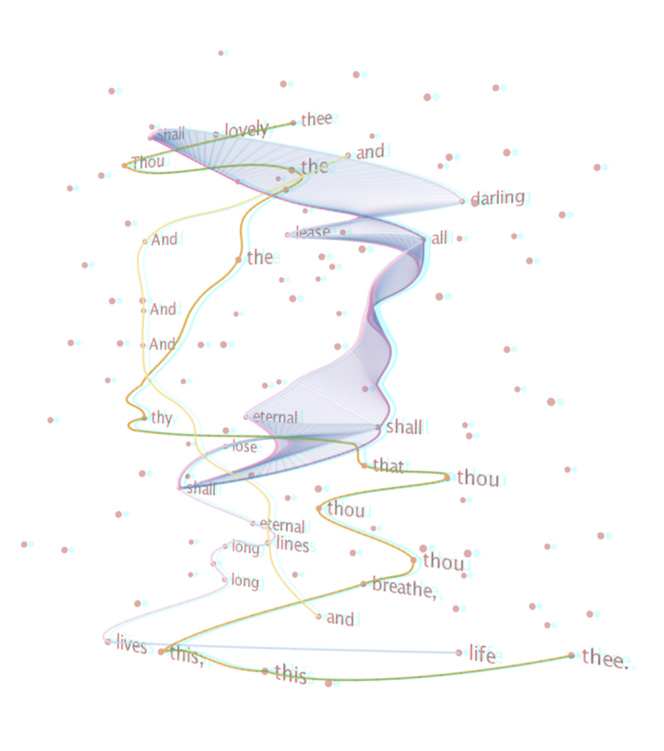
Amanda, who is also a visual artist, takes us entirely into abstraction. Here are two of her versions of Zukofsky’s ‘Celia’s Birthday Poem’ (98).
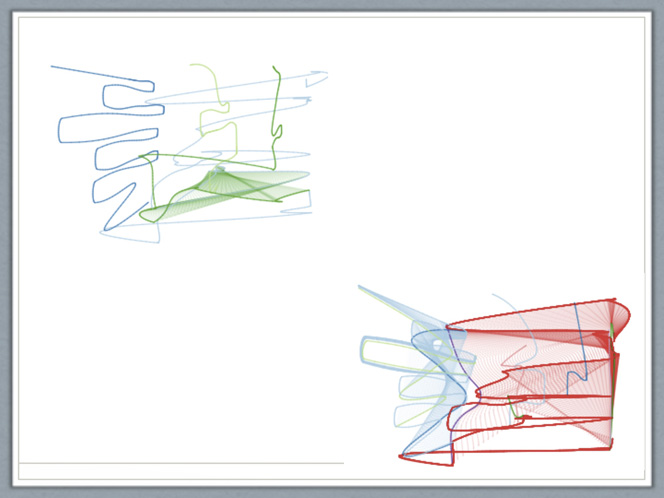
You can see that while Amanda has given us two different visual interpretations, the essential underlying sonic structures are visibly the same. It may feel as if we’ve wandered from poetry, finally, into wordlessness. But what you are seeing is a visual representation of words and their materiality in sound.
I’d like to finish by bringing us back onto territory that is more familiar, through a classic American poem everyone on the team knows well, and an insight none of us had come to before the tool. Julie, when noodling around with William Carlos Williams’ ‘This Is Just to Say’, clicked on the feature we called ‘beautiful hairball’ (and are now calling ‘beautiful mess’ for reasons having to do with the meaning of ‘hairball’ in the computer science literature), which turns on every possible sonic feature for every word then draws a great big bowl of crayon spaghetti.

As a rule, our attention goes to the words that are circled, which means they are sonically connected to some other word in the poem, to see where the movement and links are—though this tends to be difficult with the hairball. What we noticed in this case, however, is the single uncircled word, ‘you’, which appears almost dead center in the poem, and which is entirely isolated sonically. Julie has written eloquently about what isolation suggests about the poem’s emotional content and context.
Yes, working alongside the machine has altered how I read poems, shifting both my attention and my focus. But it has in no way diminished my experiences of poems. Though the thinking I’ve done about poetry in response to this project is thinking I probably wouldn’t have done without the pressure of the machine, it is, somewhat to my surprise, in keeping with my lifelong practice of observing poems, a practice that hasn’t now changed so much as it has intensified. The machine hasn’t separated me from the poems in question; rather, it has carried me deeper inside them—and it has allowed me to bring the poems more deeply into myself, into my eye, ear, mouth, and imagination.
What about meaning, then? Or wonder? Can we know too much about a poem? Does imprecision in how we think about poems really preserve a mystery that enhances our relation to them? Are poems made not of words but somehow, as Wordsworth would have it, of ‘emotion recollected in tranquility’? Do we ruin our experience of something beautiful, as Keats famously claimed in ‘Lamia’ (‘Philosophy will clip an Angel’s wings,/Conquer all mysteries by rule and line,/Empty the haunted air, and gnomèd mine—/Unweave a rainbow’) if we know how it works? In regard to sound and image as in regard to the rainbow, my own answer would be absolutely not. A more precise understanding of a poem’s operations deepens its mystery rather than inhibiting it. One can’t really get to the bottom of a good poem, not once and for all.
Even to begin to bring a computational tool for analysing poetry into existence, then, I’ve had to relearn how I think and talk about poetry. Everything I’ve said about poetry so far I have learned, by which I mean brought to mind, from this iterative process of articulation, of saying what I mean. Thus, I have learned (often reluctantly) that some important things about poetry are after all subject to quantification, even enlightening quantification. But what implications, if any, does all of this have for composition? Wordsworth’s phrase ‘spontaneous overflow’ suggests that poems come from within, independent of the poet’s volition. My experience is different, in a way this project has helped me to bring to mind. I don’t wait for words that express my emotion or experience to pop unexpectedly from some internal poetic jack-in-the-box. I attend to the world—poems, newspapers, books on mathematics, what my best friend says over red wine—looking and listening for language that creates unexpected connections, overlaps, and insights, the turbulence out of which pleasure, my own and a reader’s, might arise, even as it knocks us about. In my most delightful moments with the computer, the machine shows me relationships among words I may or may not in time have noticed on my own. It not only expands my word store, but suggests how various words are playing together, and so draws me into their dreaming realm. Here, as with reading, the tool is not an end. Rather it starts me in a place newly brought to mind, and changes how I think about reading and writing poems, and therefore, I guess also, how I do it.
Finally, then, as I have already suggested, the computer teaches me that poet and reader play, not the poem. Call the poem the playground, which provides measured space. Only a poet or reader, by activating latent turbulences, can make its ground move and so bring it back into temporality. Between readings, the poem lies inert, abandoned outside time; its relationships mean nothing until they are brought to mind.
[1] For a fuller discussion of the project’s history and its theoretical implications, please see the Spring 2015 issue of Western Humanities Review, which includes extended essays both by myself (from which some of this talk is adapted) and by my collaborator, Julie Gonnering Lein.
[2] Poemage and its back-end querying system RhymeDesign, can be downloaded at http://www.sci.utah.edu/~nmccurdy/Poemage/, where it is also possible to read various papers about the project.
[3] A video about how to use RhymeDesign, which I showed when I delivered this paper in Canberra, is available for viewing at http://www.sci.utah.edu/~nmccurdy/Poemage/.
[4] I note that this slide reflects a version of this poem I no longer use; rather, I now default to the Franklin #477, which reads ‘their paws’ instead of ‘the paws’, and which reflects the available fascicles.
Abdul-Rahman, Alfie, Julie Lein, Katharine Coles, Eamonn Maguire, Miriah Meyer, Martin Wynne, Anne E. Trefethen, Christopher Johnson, and Min Chen. ‘Rule-Based Visual Mappings—With a Case Study on Poetry Visualization.’ Computer Graphics, Forum 32 (2013). 381-390.
Barthes, Roland. S/Z. Trans. Richard Miller. New York: Hill and Wang, 1975.
Beer, Gillian. Open Fields: Science in Cultural Encounter. New York: Oxford UP, 1996.
Bogan, Louise. ‘Night.’ The Blue Estuaries: Poems 1923-1968. New York: Farrar, Straus and Giroux, 1968. 130.
Chaturvedi, Manish, Gerald Gannod, Laura Mandell, Helen Armstrong, Eric Hodgson. ‘Myopia: A Visualization Tool for Close Reading.’ DH2012. http://www.dh2012.uni-hamburg.de/conference/programme/abstracts/myopia-a-visualization-tool-in-support-of-close-reading.1.htmlDH2012. Web 22 June 2016.
Coles, Katharine. Slippage, spillage, pillage, bliss: Close reading, uncertainty, and machines. Western Humanities Review, pages 39–65, Fall 2014.
Brooks, Peter. Reading for the Plot: Design and Intention in Narrative. Cambridge: Harvard University Press, 1972.
Cameron, Sharon. Lyric Time: Dickinson and the Limits of Genre. Baltimore: Johns Hopkins UP, 1981.
Dickinson, Emily (author); Jen Bervin and Marta Werner, editors. The Gorgeous Nothings: Emily Dickinson’s Envelope Poems. New York: New Directions | Christine Burgin, October 29, 2013.
Dickinson, Emily. ‘He fumbles at your soul (477). The Poems of Emily Dickinson (Variorum Edition). Ed. R.W. Franklin. Cambridge: Belnap Press of Harvard University Press, 1998.
Graham, Jorie. Erosion. Princeton, New Jersey: Princeton University Press, May 1, 1983.
Hurtado, Amanda. Phonetic Assonance in a vowel length depth encoding of Louis
Zukofsky’s "Celia’s Birthday Poem" –rotated with words omitted. (© Amanda Hurtado)
Keats, John. ‘Lamia.’ http://www.online-literature.com/keats/2055/. Web. 22 June, 2016.
Lein, Julie Gonnering. Sounding the surfaces: Computers, context, and poetic consequence. Western Humanities Review, pages 84–109, Fall 2014.
Lein, Julie Gonnering. Depth encoded as a spectrum of sonic change in an erasure of Emily Dickinson’s "As if some little Arctic flower," rotated. (© Julie Gonnnering Lein)
Magritte, Rene. The Treachery of Images. http://collections.lacma.org/node/239578. Web 22 June, 2016.
McCurdy, Nina. Anaglyph erasure of William Shakespeare’s ‘Sonnet 18,’ visualized in 3D using stressed vowel length depth encoding. (© Nina McCurdy)
McCurdy, Nina, Julie Lein, Katharine Coles, Miriah Meyer. ‘Poemage: Visualizing the Sonic Topology of a Poem.’ IEEE Transactions on Visualization and Computer Graphics (Proceedings of Infovis 2015).
McCurdy, Nina, V. Srikumar, and M. Meyer. Rhymedesign: A tool for analyzing sonic devices in poetry. In Proceedings of Computational Linguistics for Literature, 2015.
Pound, Ezra. ‘In a Station of the Metro.’ 1918. The Poetry Foundation. Web 2 Sept. 2014.
Pound, Ezra. Lustra of Ezra Pound. London: Kessinger Publishing, LLC, 2010. Facsimile.
Williams, William Carlos. ‘This Is Just to Say.’ 1938. The Poetry Foundation. Web 6 Sept. 2014.
Wordsworth, William. ‘Observations Prefixed to Lyrical Ballads." 1800. The Poetry Foundation. Web 6 Sept. 2014.
Zukovsky, Louis. Anew. New York: New Directions, reprint edition, January 28, 2011.
Suri, Manil. ‘Don’t Expect Math to Make Sense.’ New York Times. Web 14 March 2015.